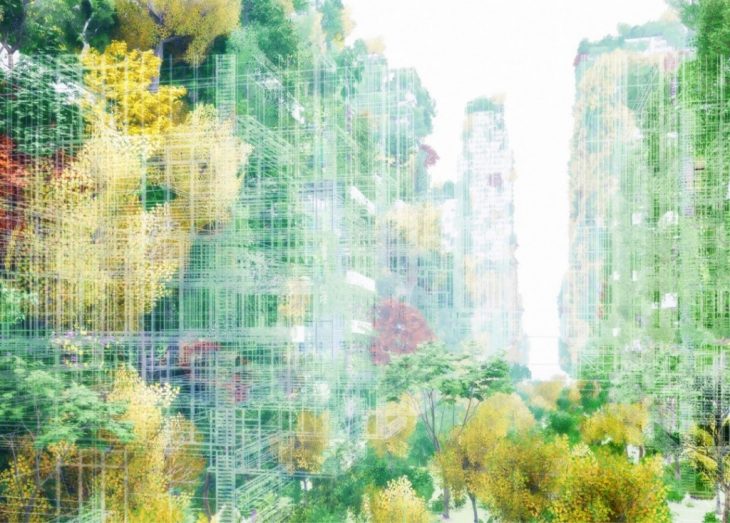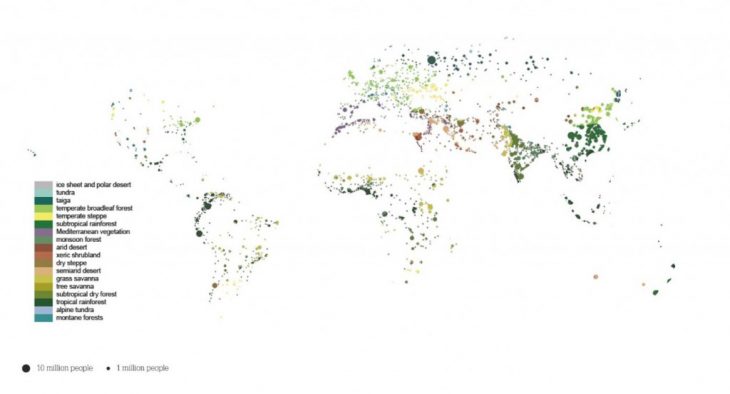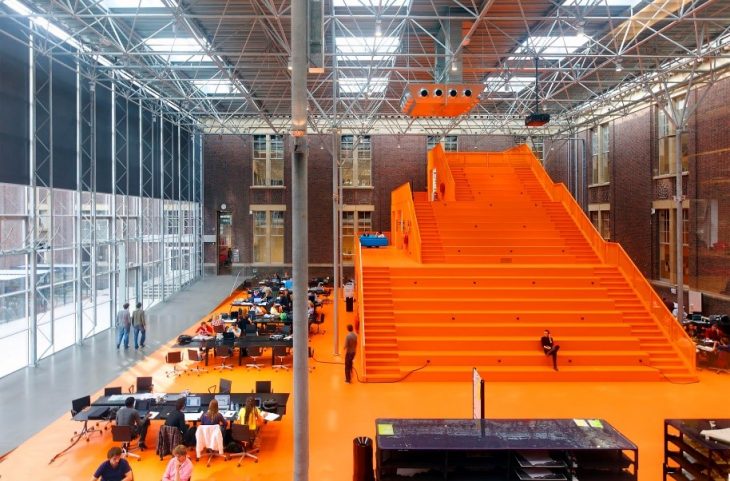Master in City & Technology 2019/20 – Term II
Workshop Name: The Green Dip – Covering the City with a Forest
Faculty: Winy Maas (Professor), Javier Arpa (Coordinator), Adrien Ravon (Teacher), Lex te Loo (Teacher Assistant)

The Research
Winy Maas reminded us in his manifesto for Domus 19 that “our planet is subject to dramatic climate change”, “the depletion of natural resources is accelerating tremendously”, “rampant desertification demands forests” and “exponential population growth requires more products, more food, more oxygen, more energy, more water and better waste treatment”.
As the discussion of environmental concerns permeates contemporary planning, urbanism and architecture, one of the solutions proposed is to wrap architecture in a verdant stratum.
Covering our buildings with vegetation is trendy; it looks good; it contributes to a green agenda; it suggests ways to help cool the city and save water; It seems to increase urban biodiversity.
But some see greening (many call it ‘greenwashing’) as a misleading real estate alibi that will not make our cities healthier or urban development more sustainable.
Some say that covering buildings with plants will simply not work because winds will blow away the grasses, shrubs or trees we sow and maintenance costs will ruin the owners. The Green Dip, an ongoing research conducted by the Why Factory (Delft University of Technology), looks critically at greening solutions for cities, and aims to produce objective data about the benefits and drawbacks of introducing nature into the built environment. The Green Dip approaches the greenwashing controversy by looking at the planet as a whole, realising that Green Dip, a Why Factory research project, analyses biomes around the world, suggesting a method to calculate environmental benefits and costs of greening cities different climates provide specific environments for native species to grow. The Green Dip proposes a method to calculate the environmental benefits and estimate the costs of greening our cities.
We studied the world’s myriad biomes and produced a catalogue of their representative native flora. For each species selected (grass, shrub and tree), we gathered data about their needs (dimensions, volume of soil, weight, water consumption, daylight hours and maintenance costs), ecosystem services and cost calculations.
This catalogue will be a database for testing and assessing different greening solutions on different urban forms.
Our ambition is to offer a precise description of the biophysical impact of covering our cities in green: from carbon related ecosystem services to air quality, storm water, energy, habitat, noise and micro climate related ecosystem services, management related activities, risks and costs.
Our research starts by analysing existing solutions for growing vegetation on buildings. We looked at rooftops, facades, balconies, etc., and their potential. We understand these spaces as a chance to introduce nature into our homes, alter our relation with the environment, and teach us that agriculture, forestry and organic production can be a catalyst for other ways of making the metropolis.
We studied the impact of planting specific species on those building parts. Then we explored a collection of different urban forms (blocks, towers, slabs, courtyards, urban villas, row houses) and developed the tools to assess this impact on the scale of the urban block.
The next step concentrated on visualisations of different greened cities (Hong Kong, São Paulo, Saint Petersburg and many more). Such visualisations respond to the analysis and calculations produced for each of the biomes where each city is located.
These visions are not mere collages. They require precision, critical and visionary thinking. We use them as a tool to illustrate the impact of different scenarios. These visions are “part curiosity, part exploration, part fantasy, and part real problem solving”. Every visualisation is accompanied by a set of objective data. How much will the temperature in the city drop? How much oxygen can be produced? How much CO2 can be captured? How much water can be stored? How many birds can be offered a life and habitat? The Green Dip project was born from the belief that green is much more than an aesthetic alibi or a passive response to the occupation of territory.
We believe that ecological principles can be an active substrate for the construction of a fertile urban form. We believe that vegetal, aquatic, environmental or climatic production has the capacity to become the primary driver and organiser of settlement.
We want to move beyond doom scenarios, guilt management and small-scale approaches to sustainability to build the future city. We reject the indiscriminate use of green as an aesthetic alibi to ensure future profits.
On the contrary, we try to overcome limitations and restrictions and liberate mankind with a more advanced understanding of nature.
We believe that understanding green as a passive response to urbanisation is a reductionist approach to land occupation. Having overcome the antagonism between town and country, between rural producers and urban consumers, we are searching for new pacts between man and nature. It is therefore necessary for nature and its production capacity be incorporated into the programming of the city.
It is time to make nature a new fermenting agent. Carbon emissions reduction, heat island or desertification prevention, and runoff management are issues that require us to put nature to work. Can we reveal the fantastic and feasible green future of our cities?
The 3%
What can greening cities do to the planet?

As part of the Green Dip research, during our 2020 Workshop at IAAC in we want to critically look at greening our cities, by assessing the impact of greening on the Planet as a whole. The workshop results will –hopefully- demonstrate, by means of visualisations and calculations, that greening cities has a beneficial impact on the urban environment and therefore in our daily lives. However, if only 3% of the Earth’s land is urbanized, what are then the benefits of greening cities?.
The production of a report and a series of innovative data visualizations will reveal the estate of our planet in relationship to urbanisation. In what condition are forests, oceans or deserts versus the urbanized areas? What are the CO2 emissions? How much is needed to compensate, reduce or even eliminate those emissions? What can cities do? How much CO2 can green cities absorb? Do we need to produce oxygen? And if so, how much can green cities produce? What is needed on the planetary scale? Can green cities help to mitigate clime change? To what extent?
The workshop aims to draw some conclusions about the actual capacity of greening the 3% of urbanized land to ‘save’ the Planet we inhabit.
The Why Factory

The Why Factory (T?F) is a global think-tank and research institute, run by MVRDV and Delft University of Technology and led by professor Winy Maas. It explores possibilities for the development of our cities by focusing on the production of models and visualizations for cities of the future.
Education and research of The Why Factory are combined in a research lab and platform that aims to analyze, theorize and construct future cities. The Why Factory investigates within the given world and produces future scenarios beyond it; from universal to specific and global to local. It proposes, constructs and envisions hypothetical societies and cities; from science to fiction and vice versa. The Why Factory thus acts as a future world scenario making machinery.
We want to engage in a public debate on architecture and urbanism. The Why Factory’s findings are therefore communicated to a broad public in a variety of ways, including exhibitions, publications, workshops, and panel discussions.
The work of The Why Factory has been exhibited at various events, such as the Business of Design Week, 2009, Hong Kong; Foodprint Manifestation, 2009, Den Haag; Imaginarium, 2010, Berlin; and Vertical Village, which has been shown in the Museum of Tomorrow, Taipei, 2011, at The Total Museum of Contemporary Art, Seoul, 2012 and Hamburg Museum, Hamburg, 2013, COAM Madrid, Madrid, 2016, Munich Architecture Gallery, Munich, 2017, Dutch Design Week, Eindhoven, 2017, Centre Pompidou, Paris 2018, Manifesta Biennale, Marseille 2018.
At the core of The Why Factory’s campaign is a series of books —the ‘Future Cities Series’—, which is being published in association with nai010 publishers in Rotterdam. In the ‘Future Cities Series’ the following books have been published: Visionary Cities (2009), Green Dream (2010), The Why Factor(y) (2010), The Vertical Village (2011), Hong Kong Fantasies (2011), City Shock (2012), World Wonders (2014) and Barba (2015), Absolute Leisure (2016), Copy Paste (2017), PoroCity (2018), Tower of Choice (2019). Upcoming publications are, (w)ego, Green Dip, BiodiverCity, 4 Minute City, and Planet Maker.
